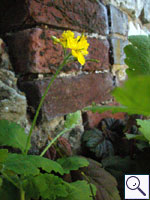|
||||||
|
CHELIDONIUM. Greater Celandine. [Papaveraceae] |
|
|
Greater Celandine (C. majus) is the only species of Chelidonium recorded from Britain. It is a native species. Two British miners are recorded on Chelidonium. A key to the European miners recorded on Chelidonium is provided in Bladmineerders van Europa. |
|
Key for the identification of the known mines of British |
| 1a > Leaf-miner: Mine linear, whitish, both upper and lower surface. Pupation internal, at the end of the mine with the anterior spiracles projecting through the epidermis (Spencer, 1976: 433). Upper-surface, less often lower-surface corridor. Frass in isolated grains. Pupation within the mine, in a, usually lower-surface, pupal chamber. A long whitish upper surface corridor, which eventually goes lower surface. |
|
Chromatomyia horticola (Goureau, 1851) [Diptera: Agromyzidae]. |
1b > Leaf-miner: Corridor-blotch mine, normally dorsal; usually whitish; in small leaves it lies characteristically in the centre of the leaf often touching the petiole; in larger leaves it lies to one side of the mid-rib. Frass deposited in green clumps near the leaf margin. Pupation usually external, sometimes in a separate pupation mine. Oviposition whitin the leaf, at the lower surface. The first part of the mine is a long, sometimes very long, corridor, that mostly will be overrun by the later developments. Generally this corridor is directed, frequently guided by a thick vein, to the midrib. The next section of the mine is large, irregular blotch overlying the basal section of the midrib. Locally large chunks of midrib tissue are consumed. From this central blotch excursions are made into the leaf blade: generally upper-surface, less often lower-surface and locally full-depth. In plants with narrow leaves, like Diplotaxis, the mine may occupy the entire width of the leaf. Often several larvae together in a mine. Frass blackish green, powdery, in clouds, sometimes along the sides of the corridors, later more in the periphery of the mine and in the end of extensions of the blotch, sometimes seemingly absent. (Often the frass can only be seen after the mine has been opened). Pupation generally in the ground, rarely within he leaf, in a short mine without frass. Hendel (1928a) described the biology, larva and puparium. An initial narrow gallery then leads to a blotch on the midrib of the leaf. Watch a video of a scaptomyzid fly larva on Arabidopsis on YouTube by mash92587. |
| Polyphagous. On numerous genera of Brassicaceae, Asteraceae, Papaveraceae, Resedaceae, Tropaeolaceae and Violaceae, including Alliaria, Barbarea, Brassica, Cheiranthus, Cochlearia, Coincyia, Conringia, Diplotaxis, ? Eruca, Erysimum, ? Hesperis. Lepidium, Matthiola, Raphanus, ? Rorippa and Sinapis, but not yet on Chelidonium, in Britain and additional genera of these families, including ? Chelidonium and Fabaceae elsewhere. Widespread, from Caithness in the north to Cornwall in the south of Britain. Also recorded in the Republic of Ireland, Europe, the East Palaearctic, Near East and Neartic Region. |
Scaptomyza flava (Fallén, 1823) [Diptera: Drosophilidae]. |
| Last updated 02-Jul-2019 Brian Pitkin | ||

